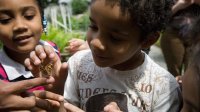Focusing on Science With Elementary Students This Year
Science instruction boosts students’ curiosity and encourages collaboration, which will help them transition back to in-person school.
Your content has been saved!
Go to My Saved Content.Looking to help students grow academically, engage deeply in their learning, and cultivate critical social and emotional learning (SEL) competencies after more than a year of virtual and hybrid instruction? Science—and evidence-based methods for teaching it—can help.
The 2018 National Survey of Science and Mathematics Education found that students in grades K–3 were taught science for an average of just 18 minutes a day, compared with 89 minutes for English language arts and 57 minutes for math. Science instructional time is only marginally greater in the upper-elementary grades. And those are averages, which means many children go whole days and even weeks without science instruction. Amid the pandemic, science instruction often has been shoved even further aside.
While math and reading are essential subjects, elementary students need more science instruction. By creating time for science, school leaders and educators give students the space and opportunity to build knowledge, interact with classmates, problem-solve, and engage in important content at an age when they are at their most curious. Today’s young people need to study and understand their world so that as young adults they can make decisions that have a positive impact.
Current practice simply isn’t working, as evidenced by the latest National Assessment of Educational Progress, known as the gold standard in student assessments. Science scores were down on the latest assessment in elementary school and flat in middle and high school.
As a lifelong science educator, I believe high-quality science instruction is essential. It takes advantage of students’ innate curiosity, boosts discourse and engagement, and enhances important social and emotional skills such as teamwork, self-management, and critical thinking. Great science instruction also encourages students to drive their learning through exploration. Those are exactly the kind of learning experiences students need as they transition back to in-person school this year.
3 Key Steps for Making Science More Engaging
1. Use phenomena: Anchoring lessons in observable events that can be explained or predicted through scientific understanding motivates students, allowing them to ask questions, make observations, and conduct investigations to understand and explain the world. For example, fourth-grade students might investigate how elephants sense rainstorms that are hundreds of miles away. This leads students to share ideas about related phenomena, such as pet dogs knowing when someone is at the door before people know. By incorporating phenomena in this manner, students interact with a web of interrelated events that help them connect core science ideas—in this case, how we respond when we sense information in our environment.
2. Integrate art and literature into your lessons: Science lends itself to interdisciplinary learning, which tends to be highly engaging. For example, when studying windmills in an energy unit, consider exploring Piet Mondrian’s windmill paintings or incorporating The Boy Who Harnessed the Wind, by William Kamkwamba and Bryan Mealer, a nonfiction text about a Malawian boy who builds his own windmill and brings electricity to his village. This gives your students who love art or literature a window into science.
3. Use engaging instructional routines: Many of these may already be in your toolbox.
- For K–2, the “tableau routine” allows students to visually and kinesthetically express understanding of a concept by communicating about it without words. Students use their bodies and facial expressions to create a scene, or tableau, that represents a concept. For example, they can pose in ways that show how plants respond to specific water and light conditions during an investigation.
- The “jigsaw routine” helps students in third grade and above digest complex texts. Students are split into groups, and each group studies a section of text, becoming an expert on that portion. The groups then share what they learned. For example, students can read about fossils found in each rock layer of the Grand Canyon, reporting their findings to their peers and comparing the layers they studied to others.
- And the “chalk-talk routine” is a silent exercise that encourages universal participation by giving students a chance to organize their thinking by first writing their thoughts and questions about a topic on sheets of chart paper. As students consider each topic, they build on their peers’ ideas, respond to questions, and write follow-up questions. I’ve seen teachers use this routine to explore different solutions for mitigating severe weather damage.
Teachers can leverage the power of science when working to address learning challenges exacerbated by the pandemic. Emphasizing science instruction, using evidence-based strategies and routines, and exploring real-world phenomena will pique students’ interest and help them with vital skills while giving more attention to a core academic subject that has too often been neglected.
